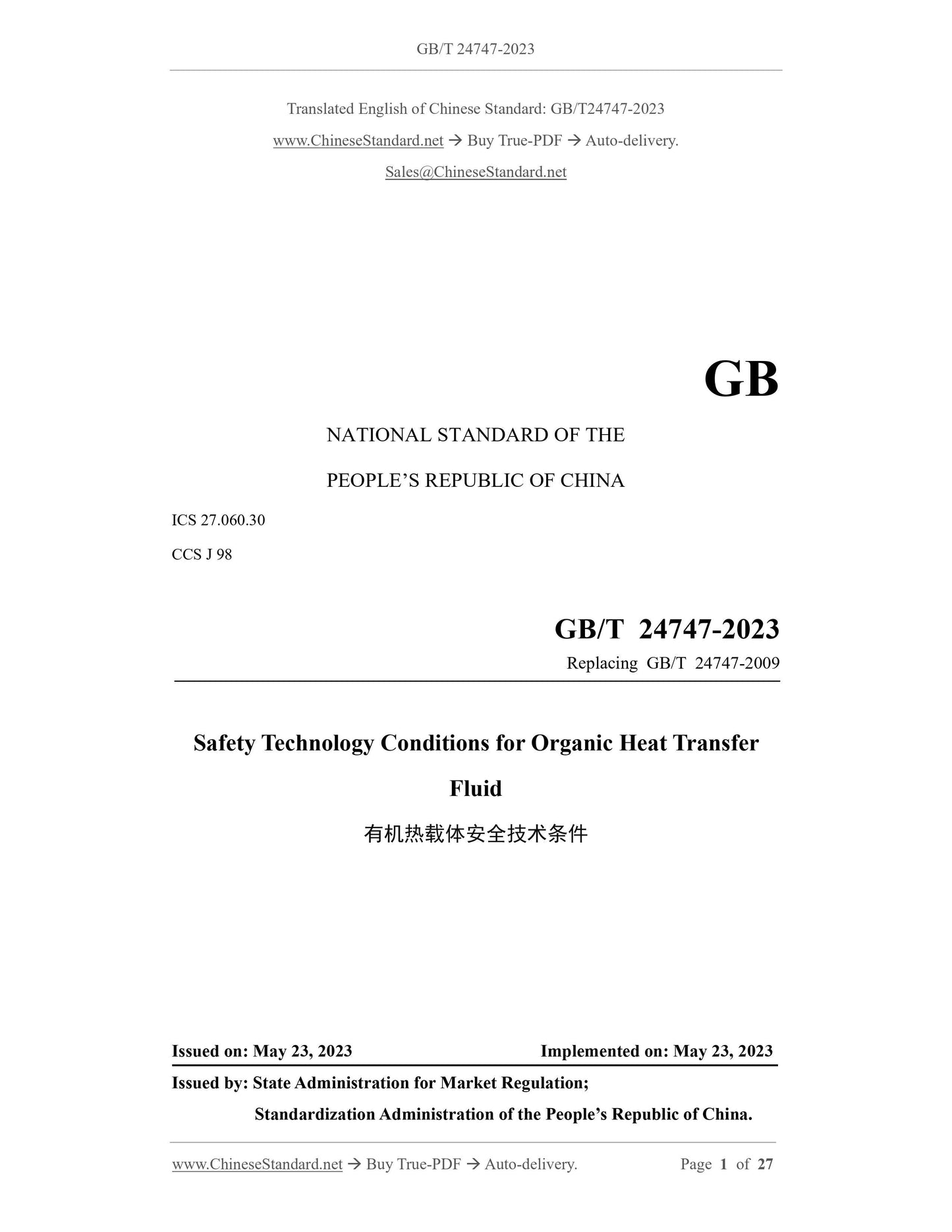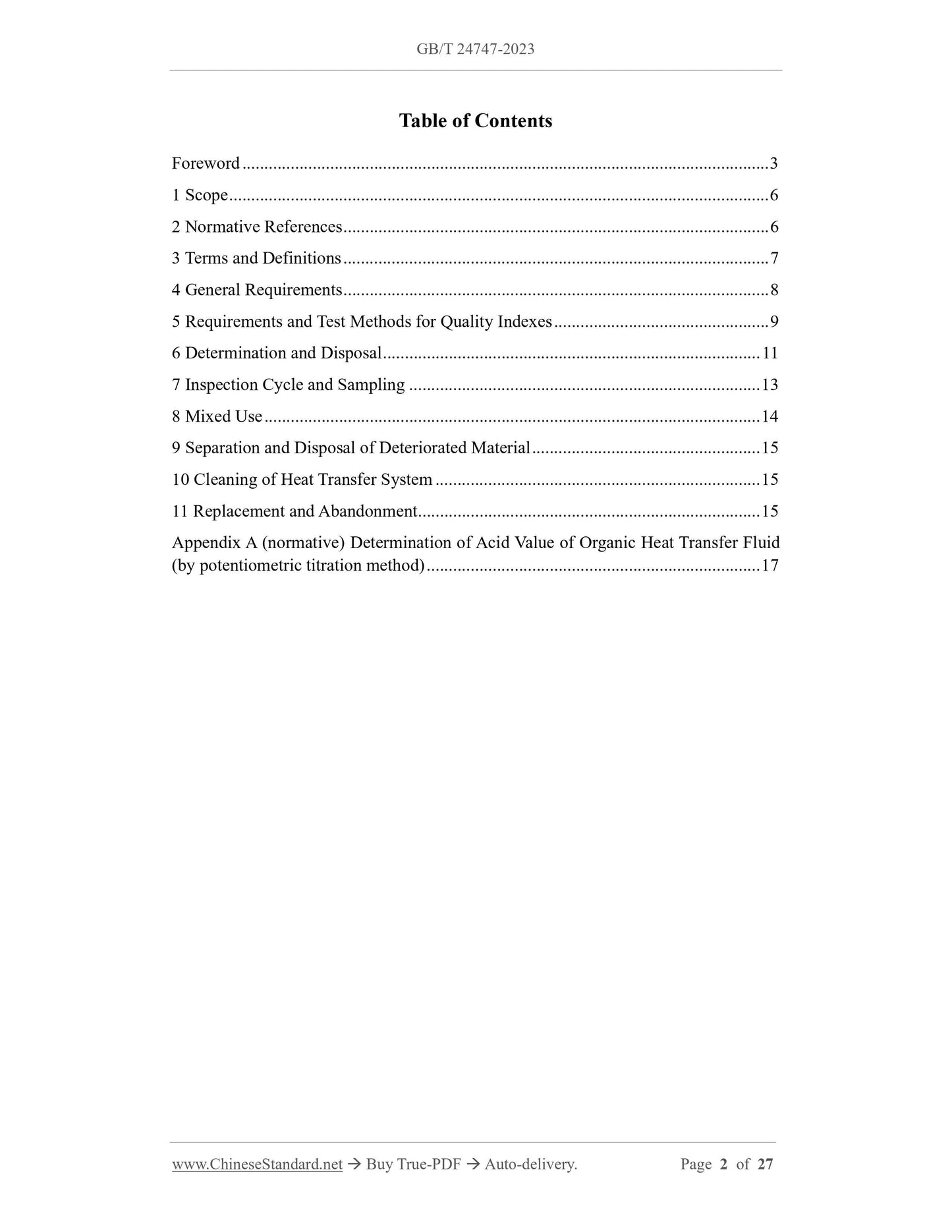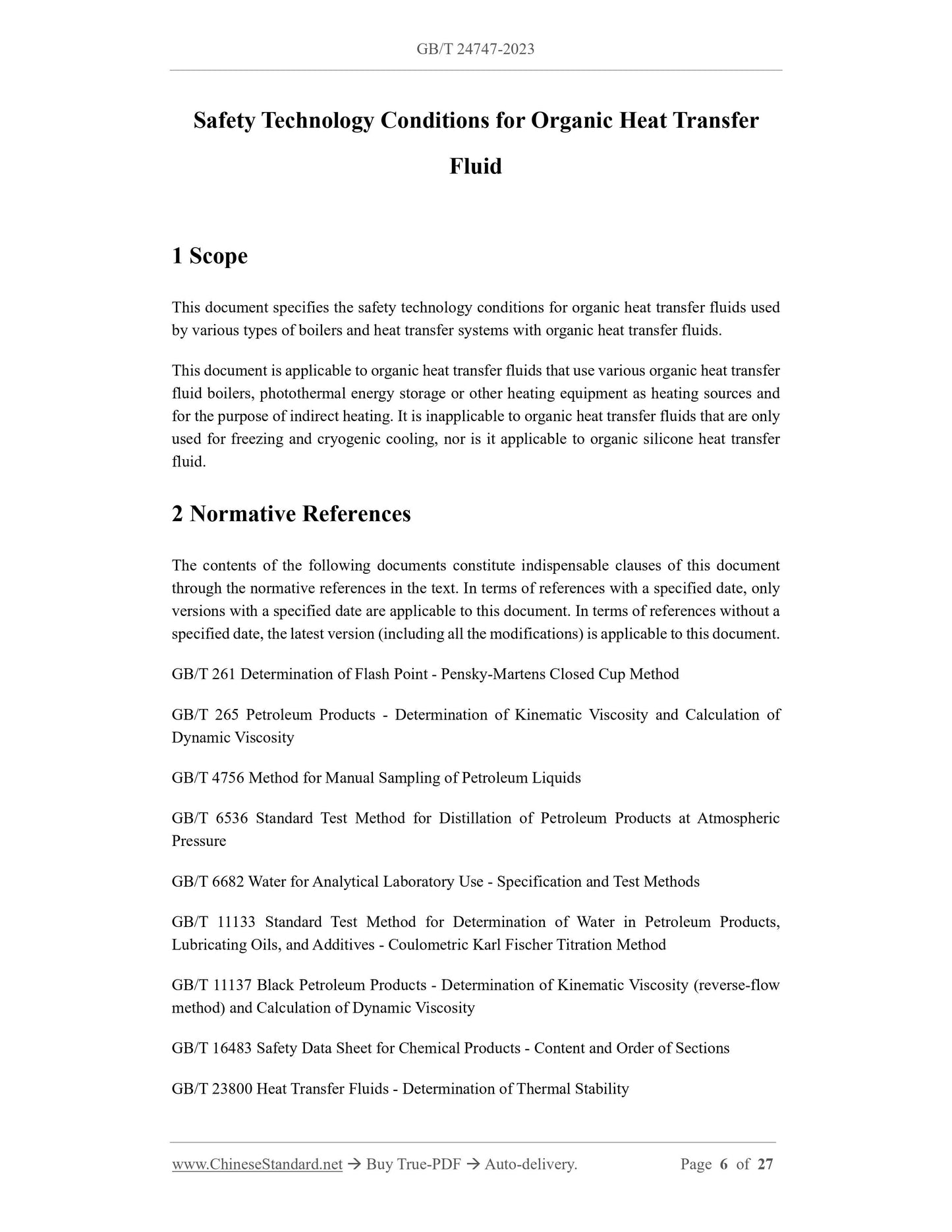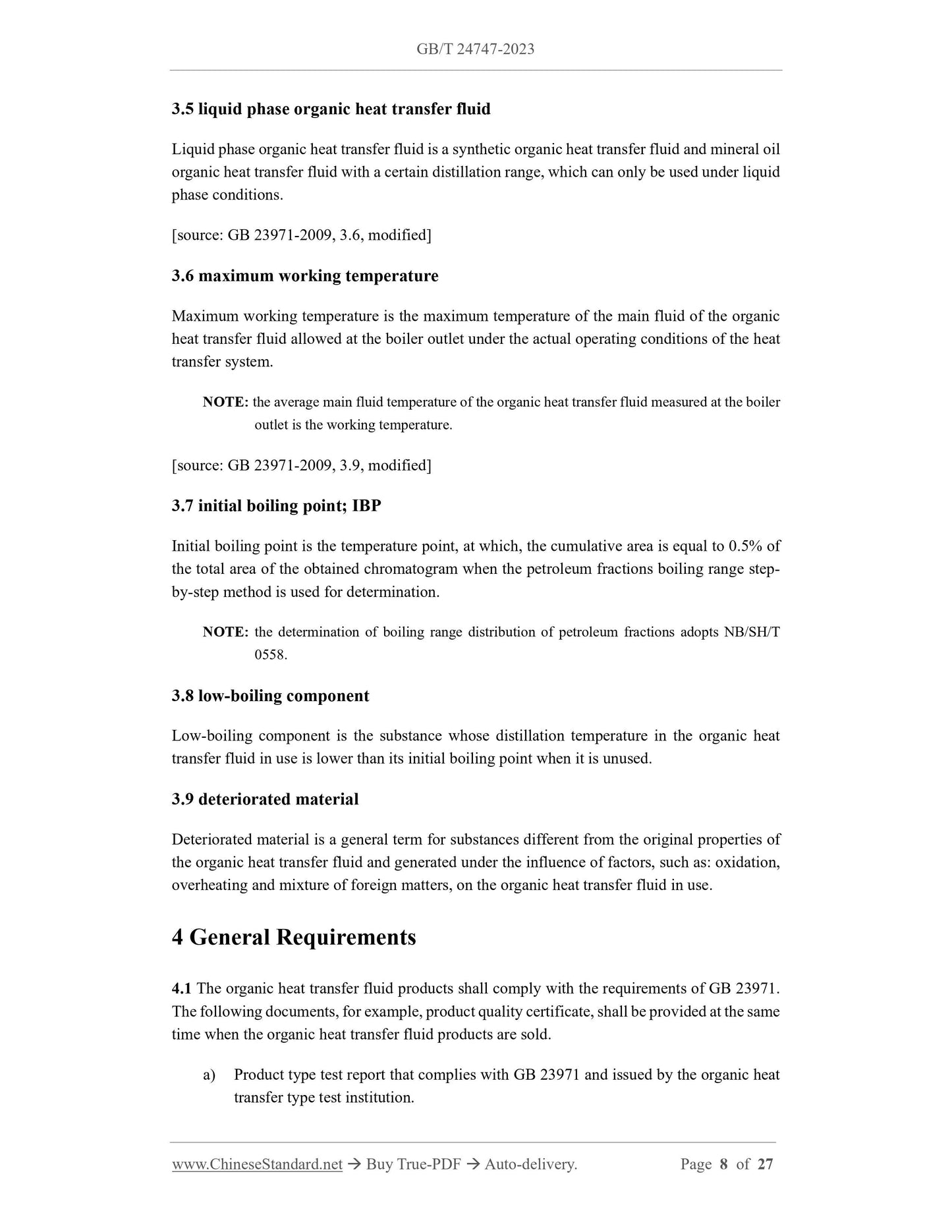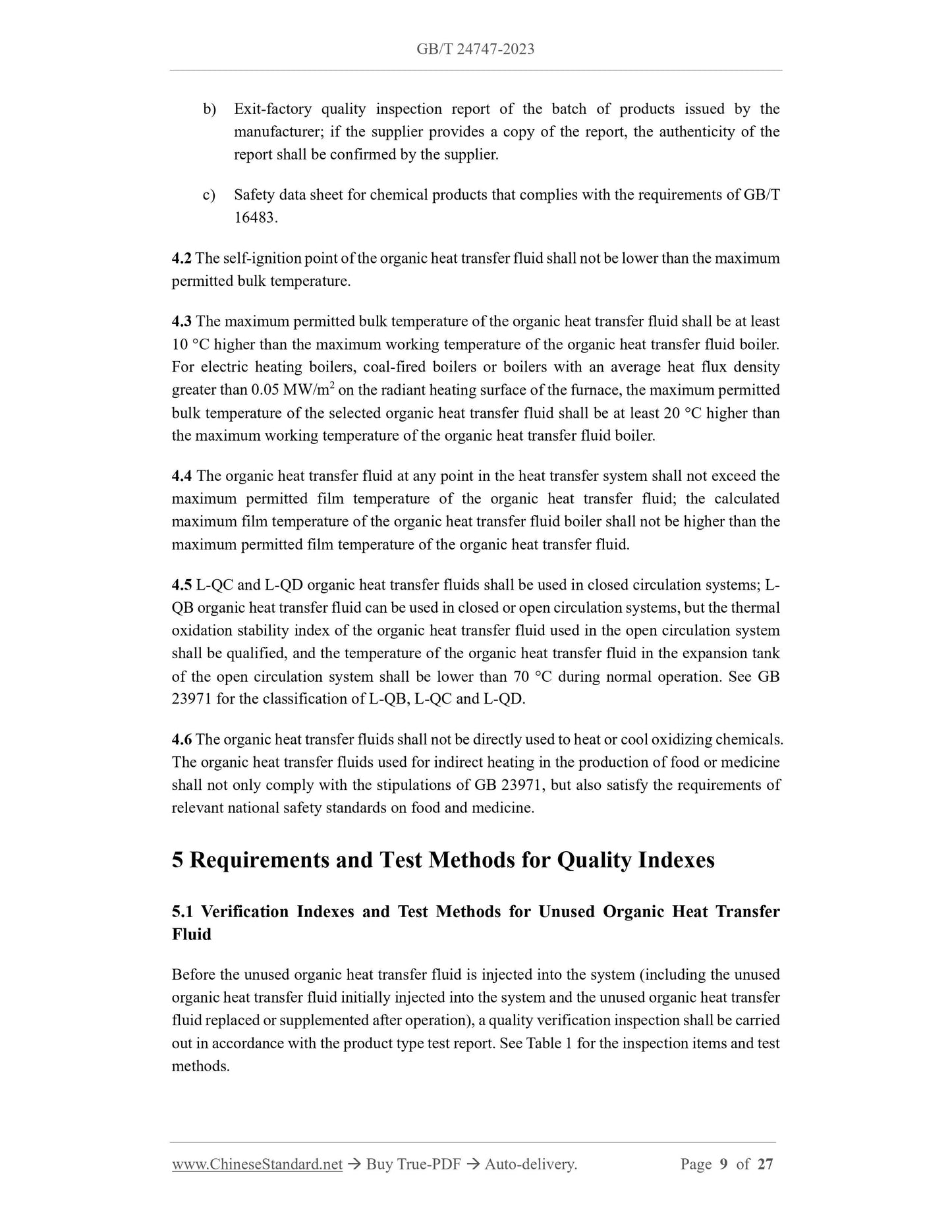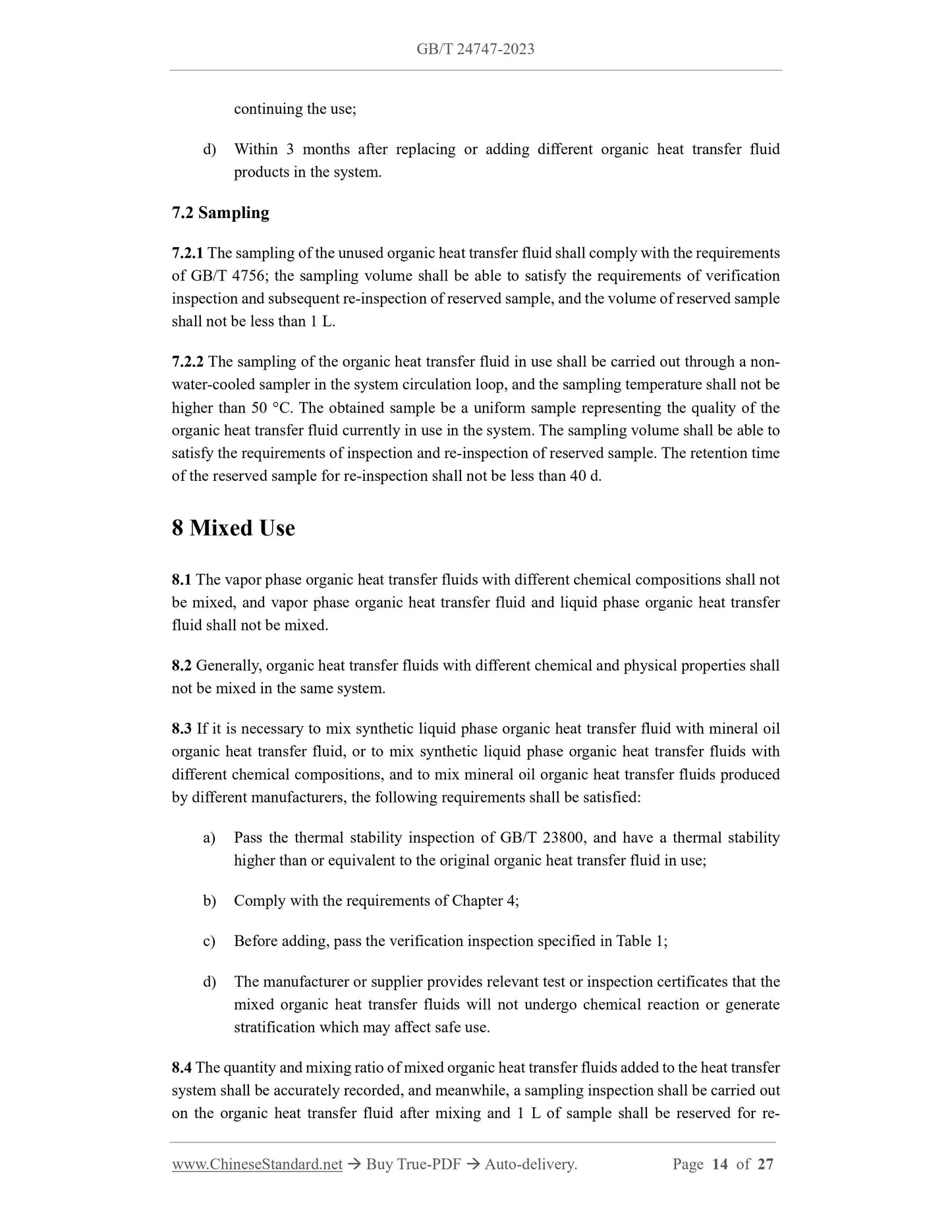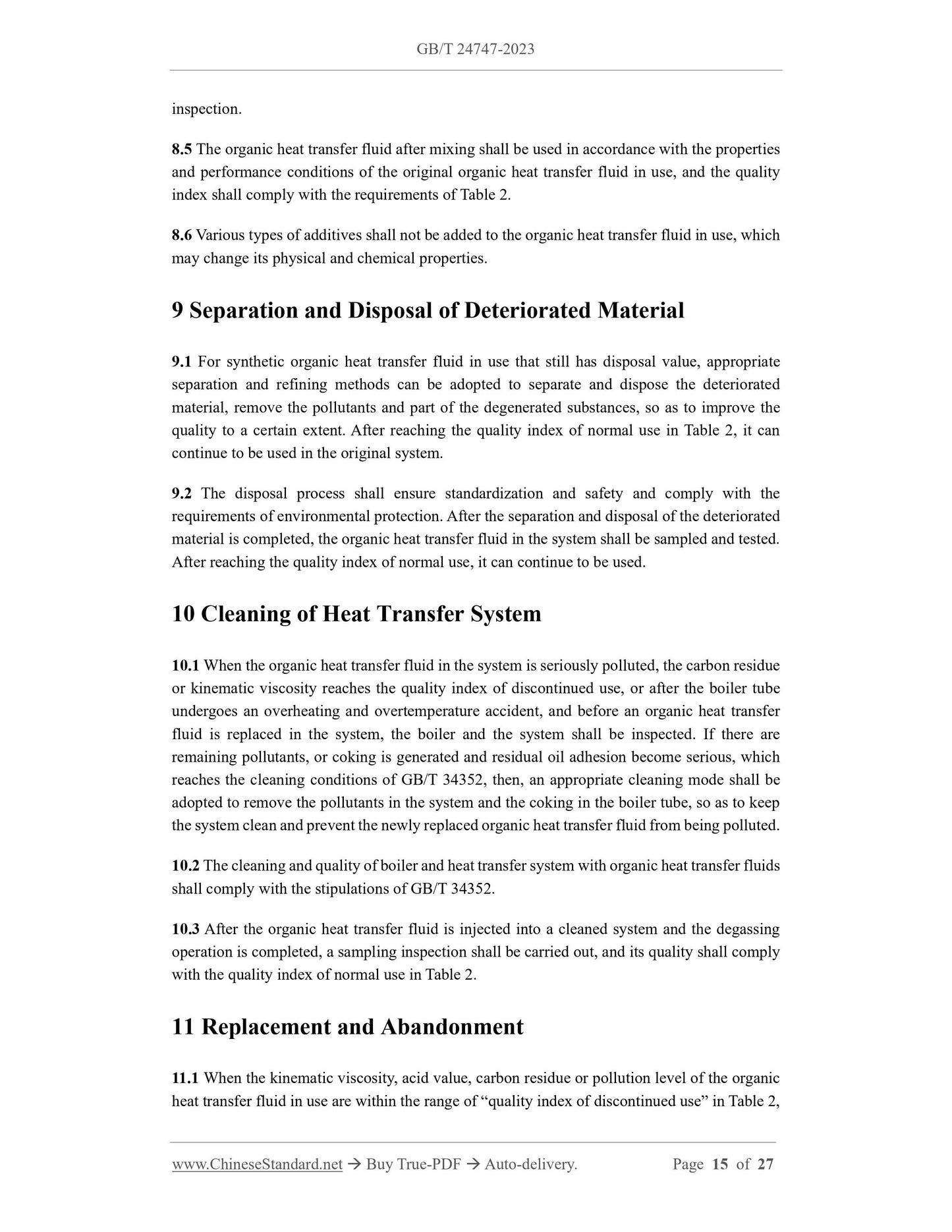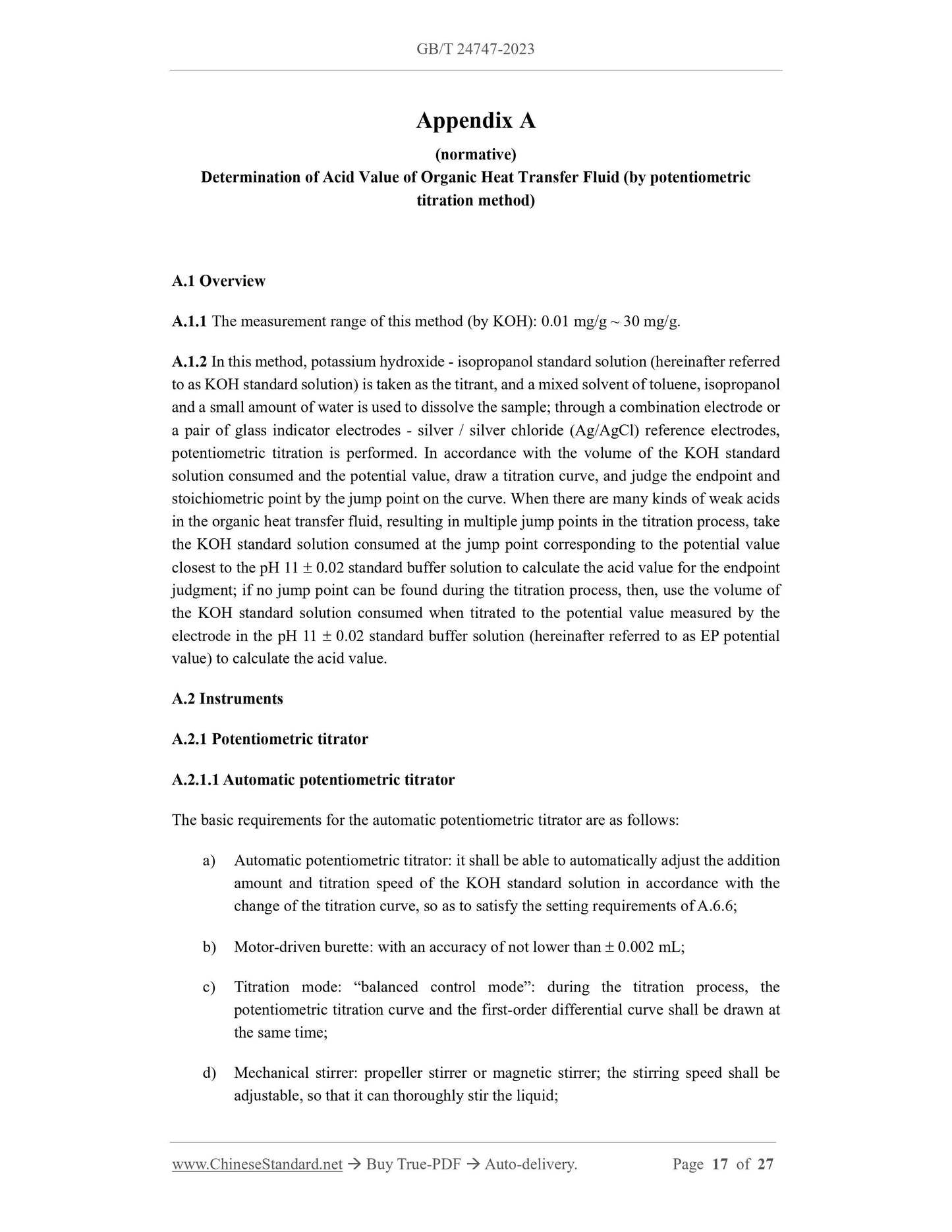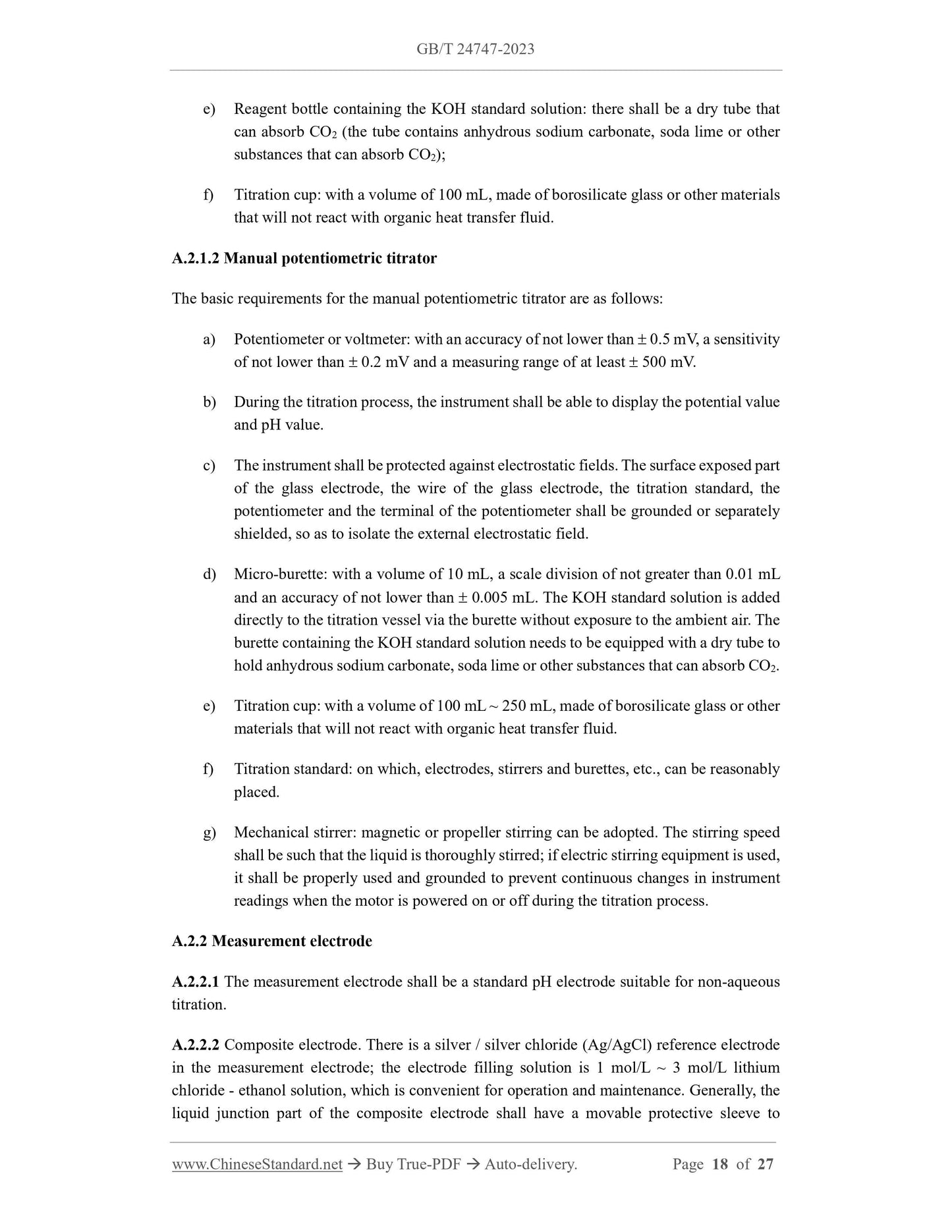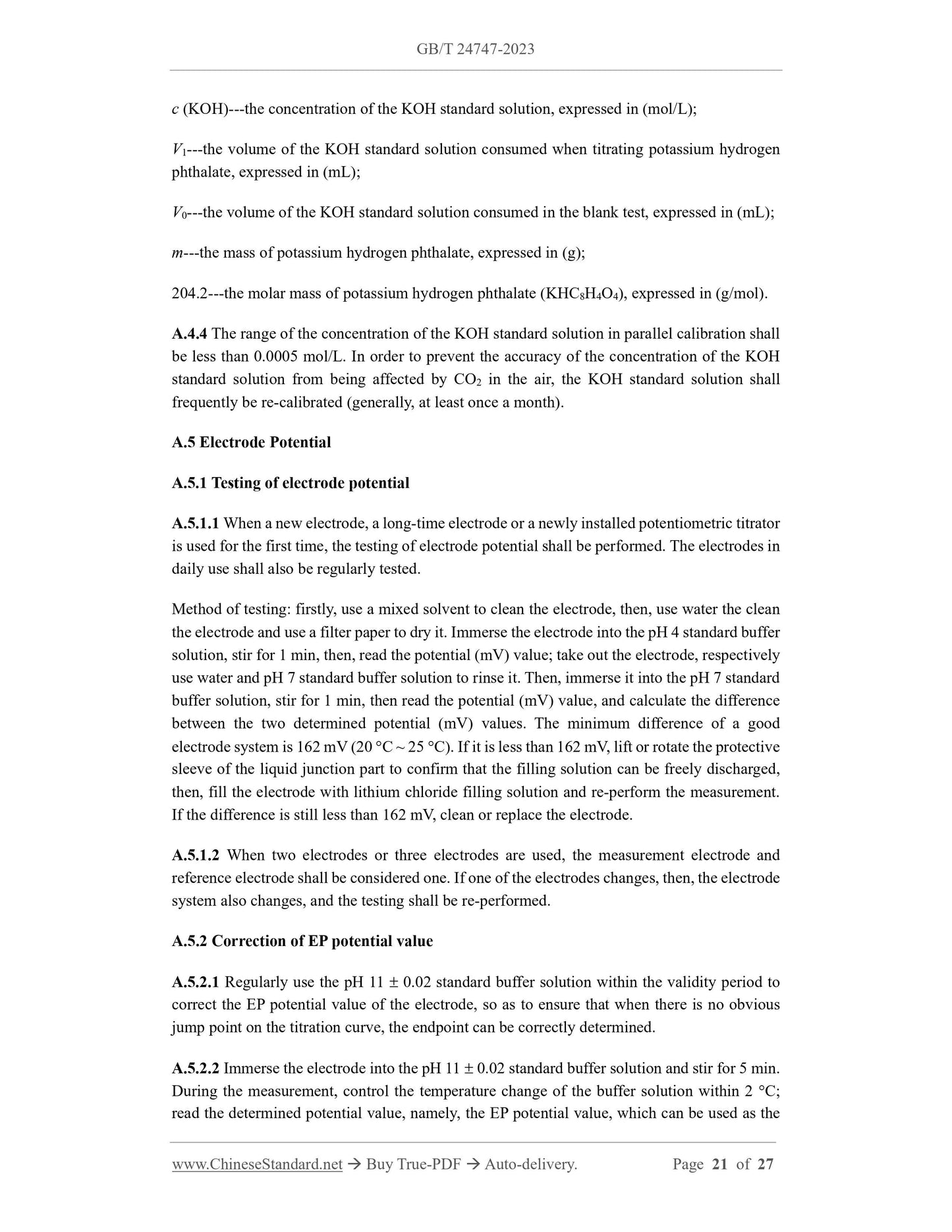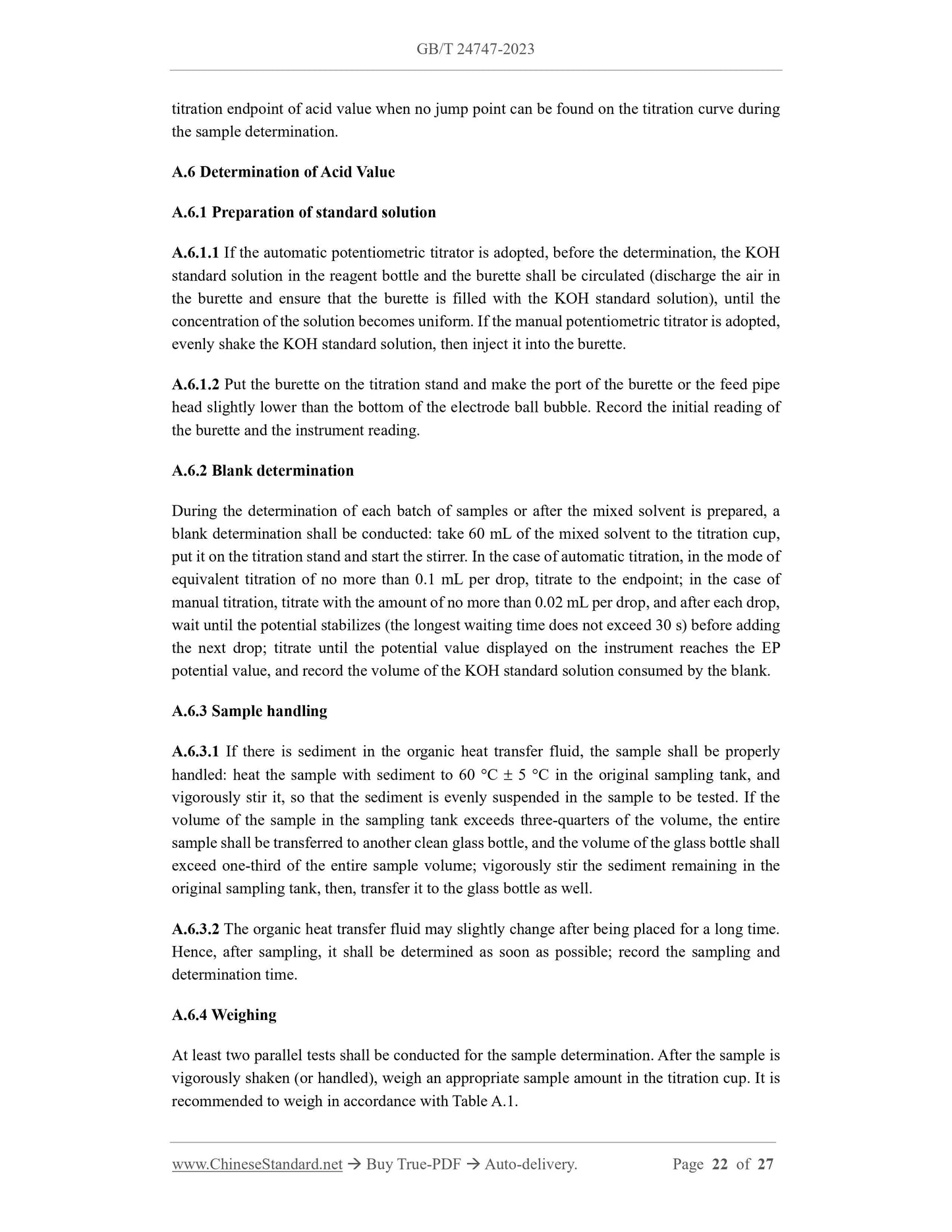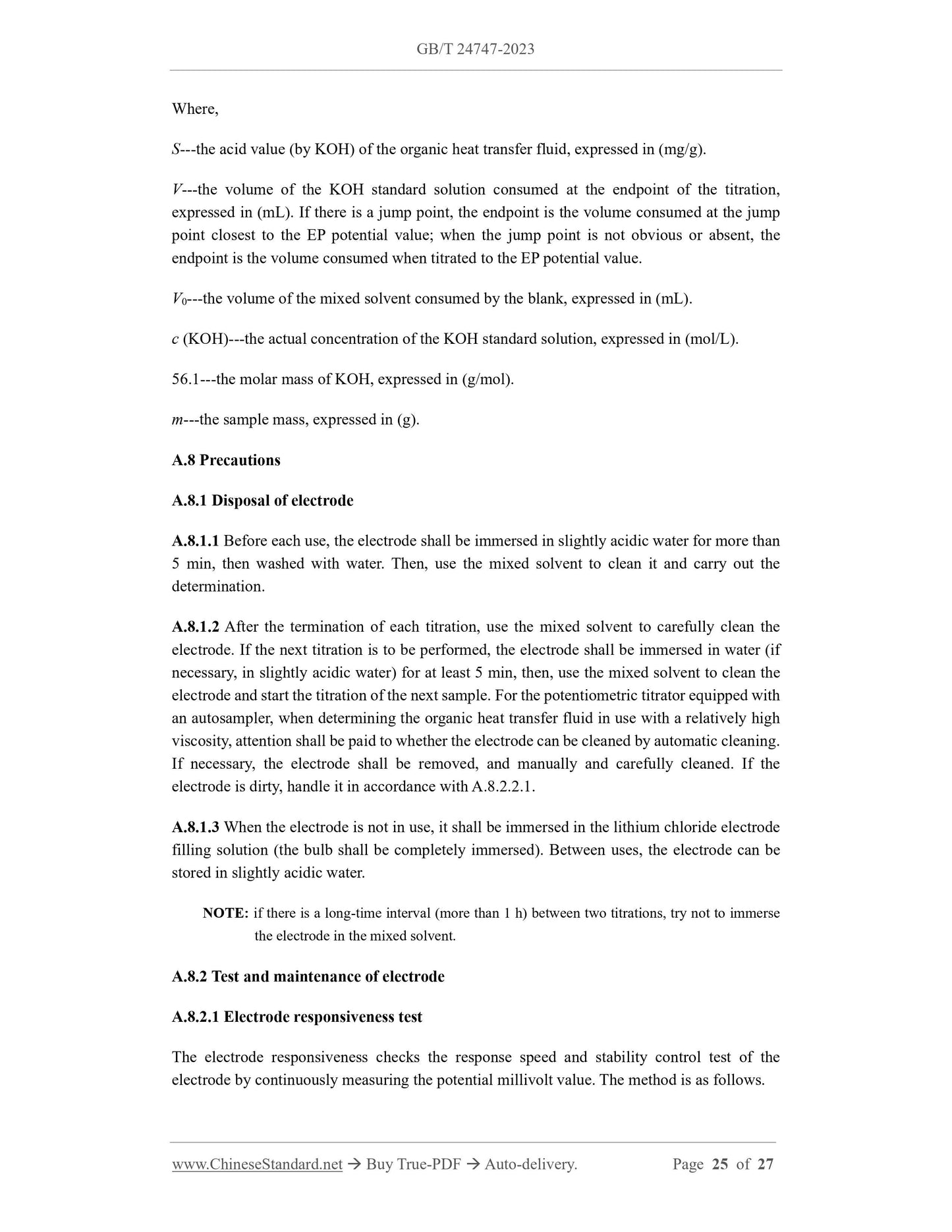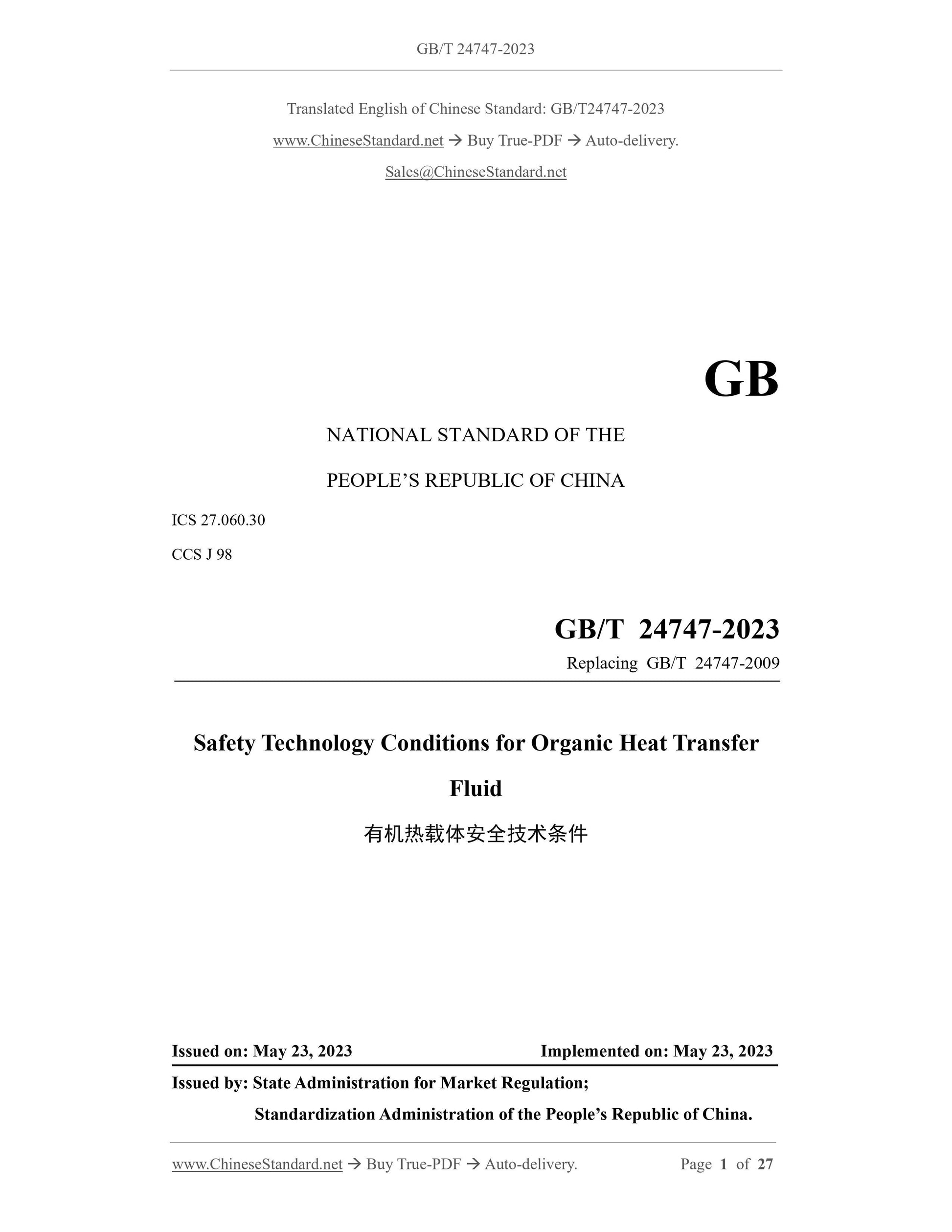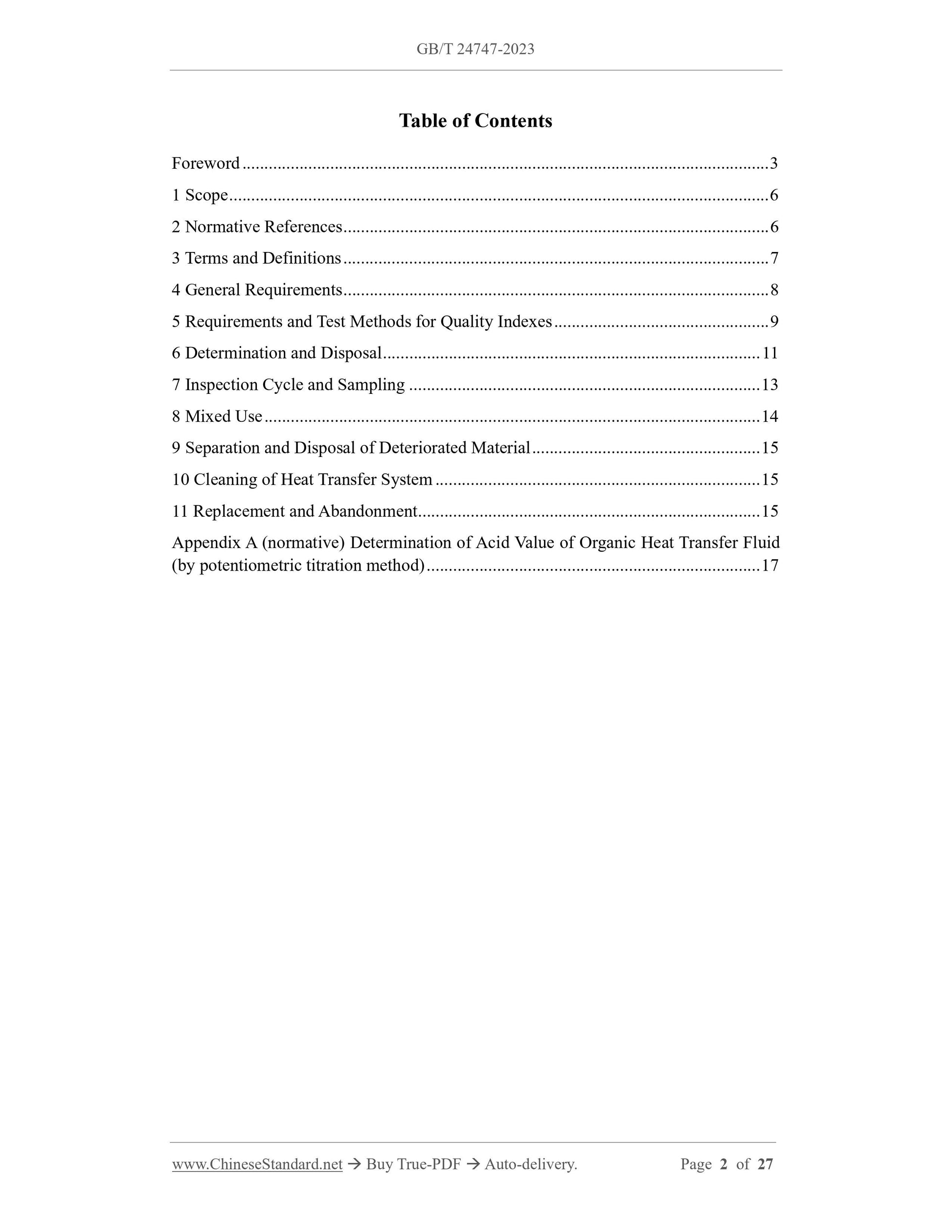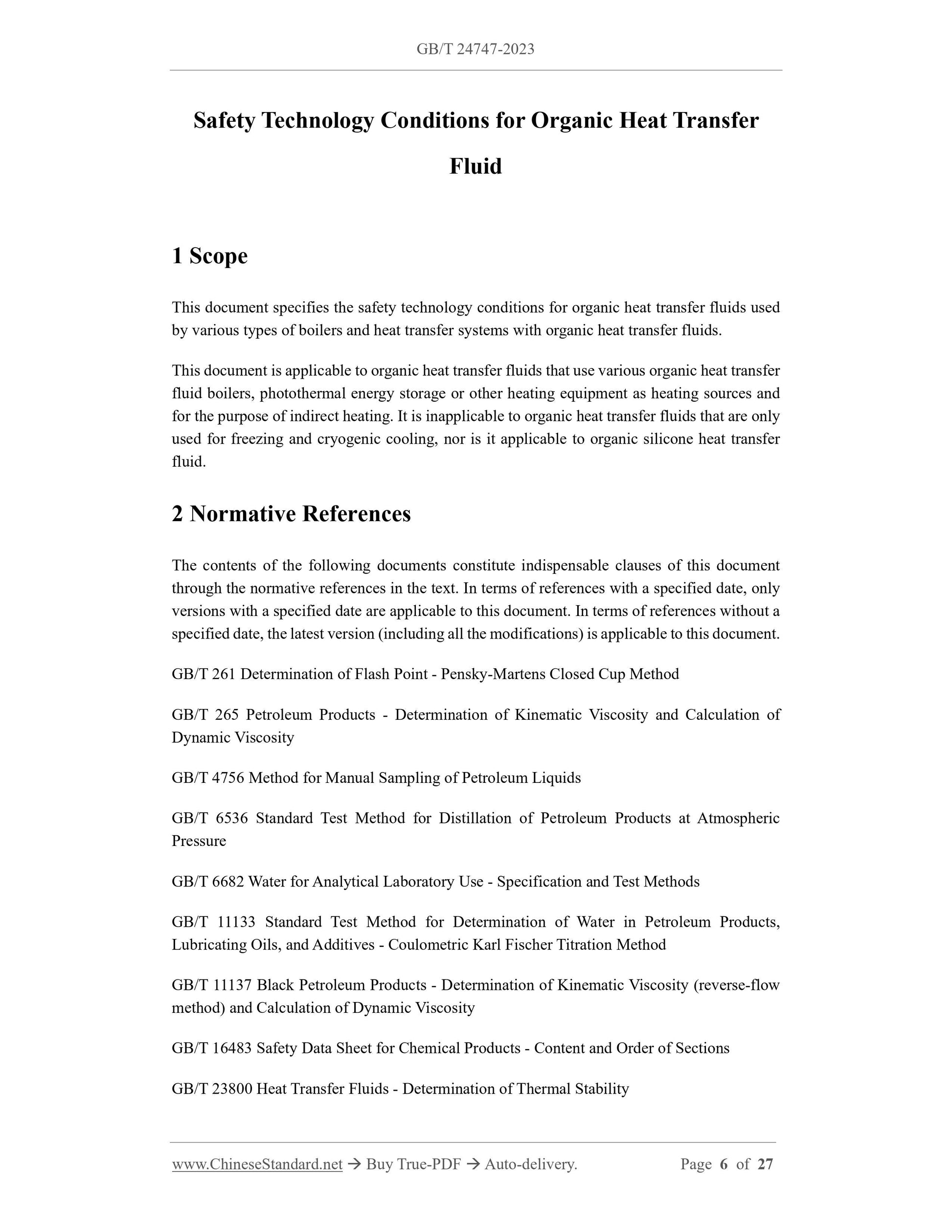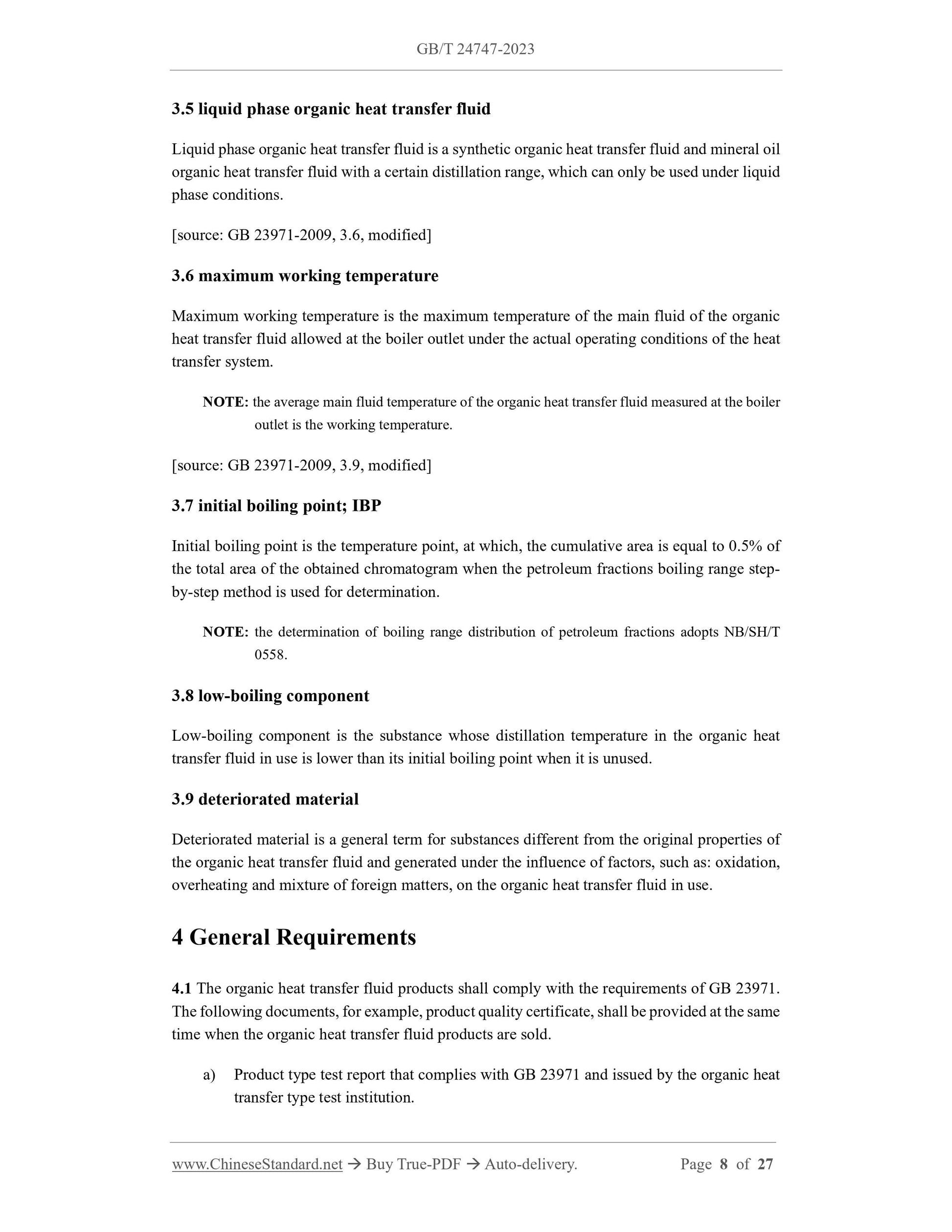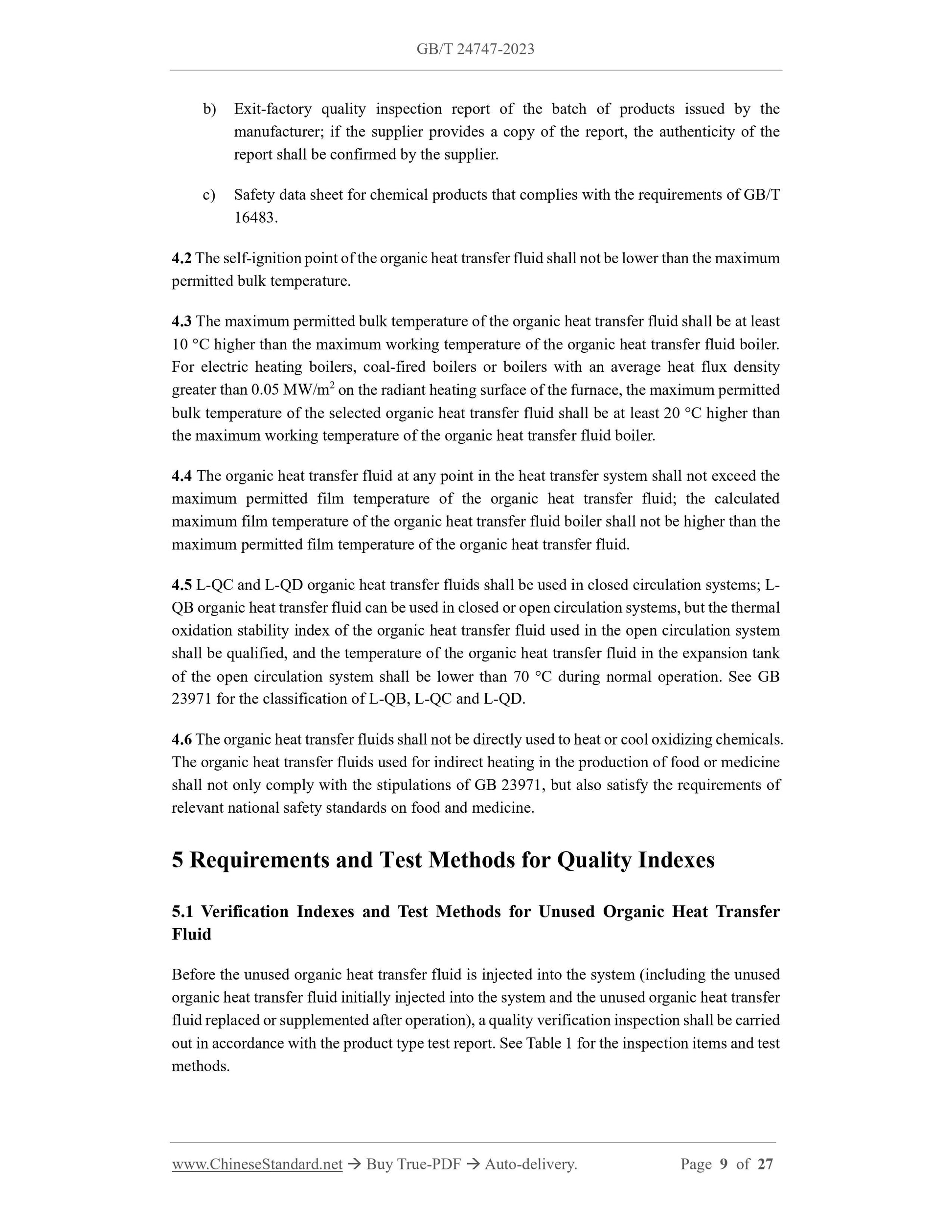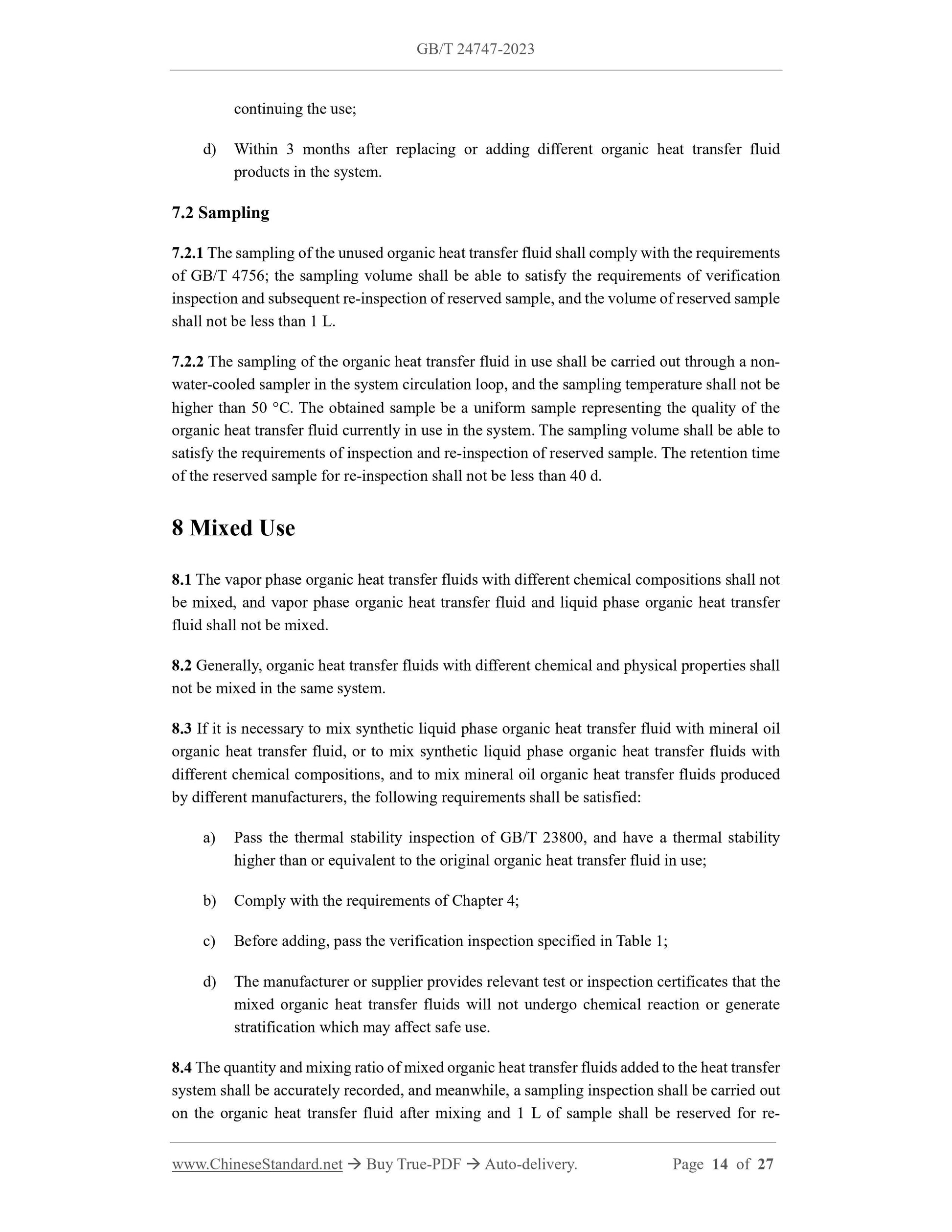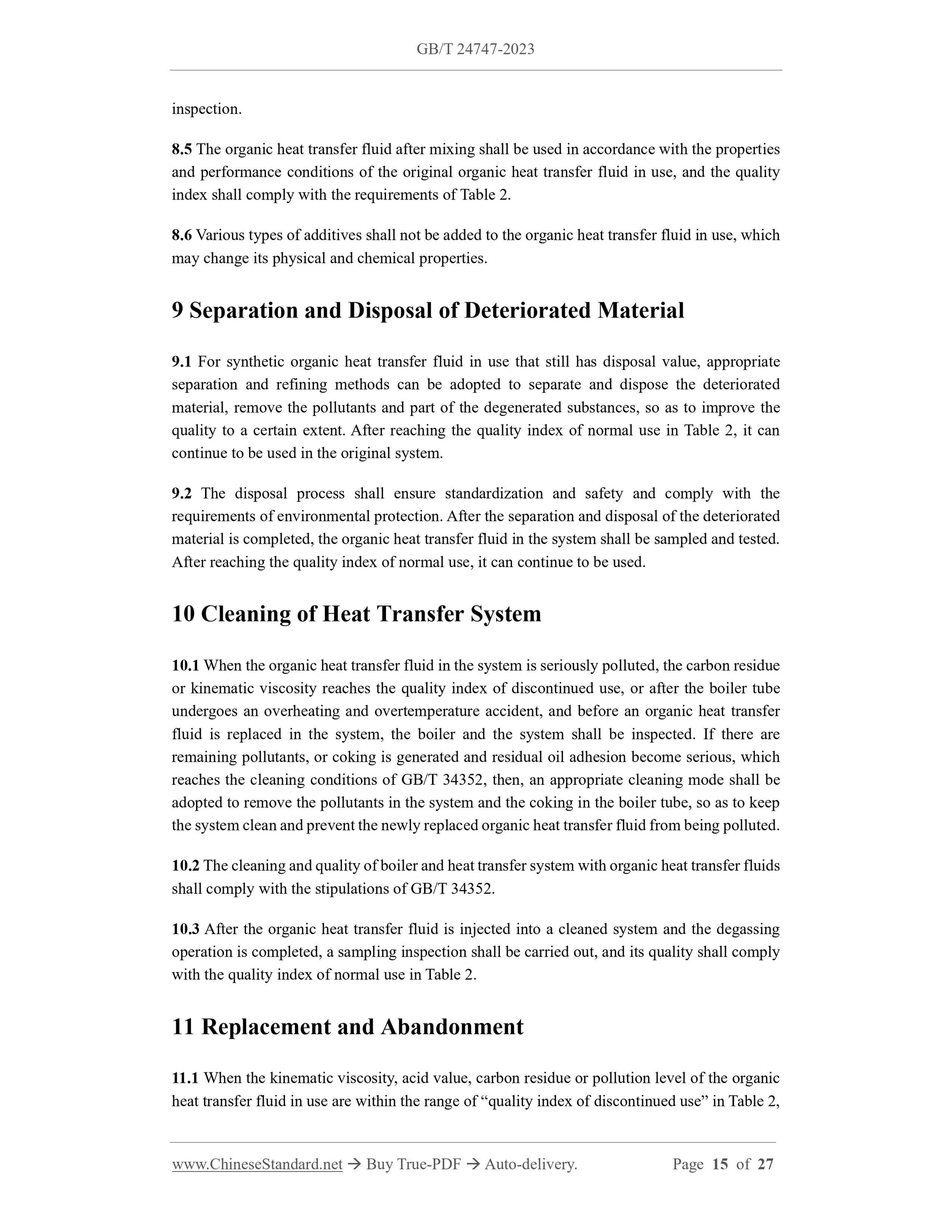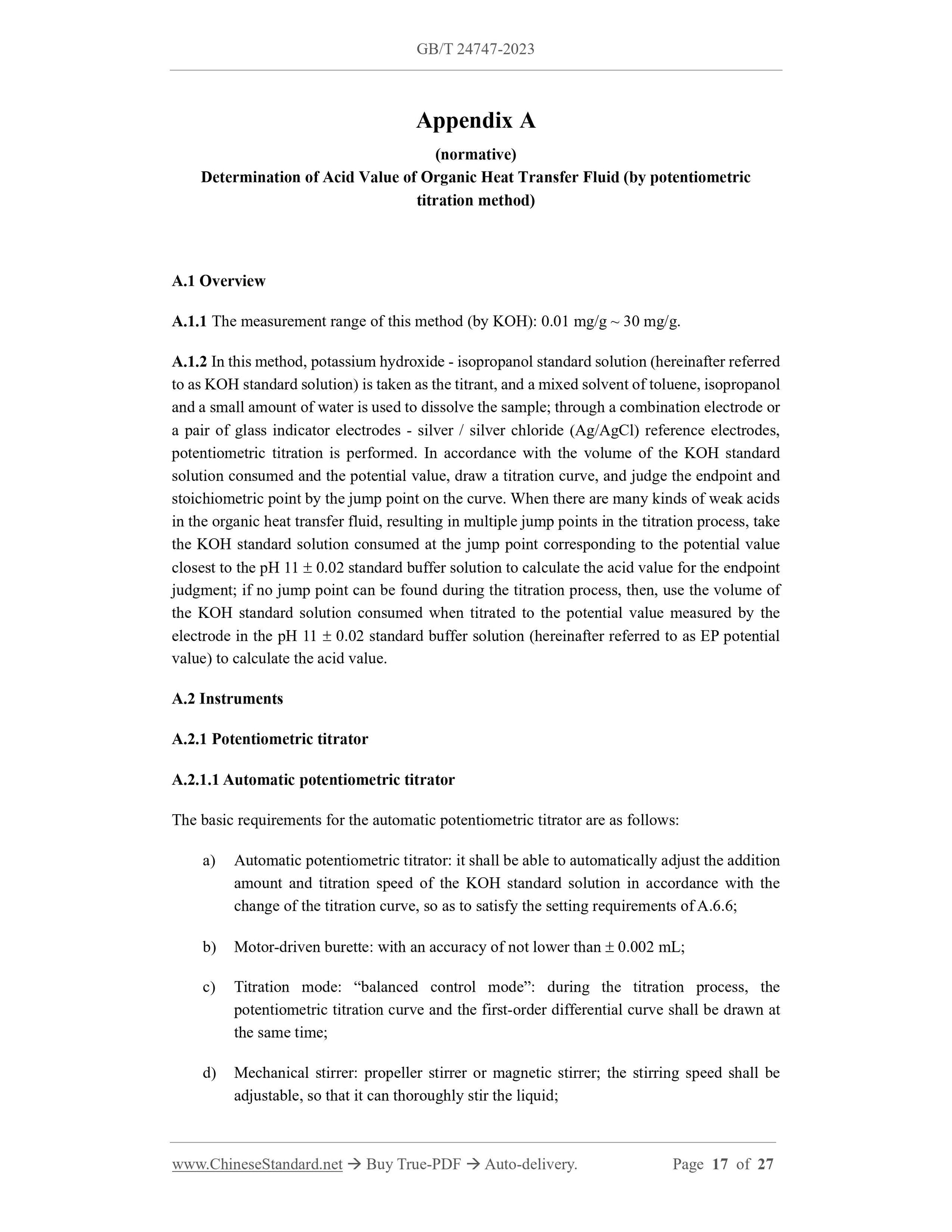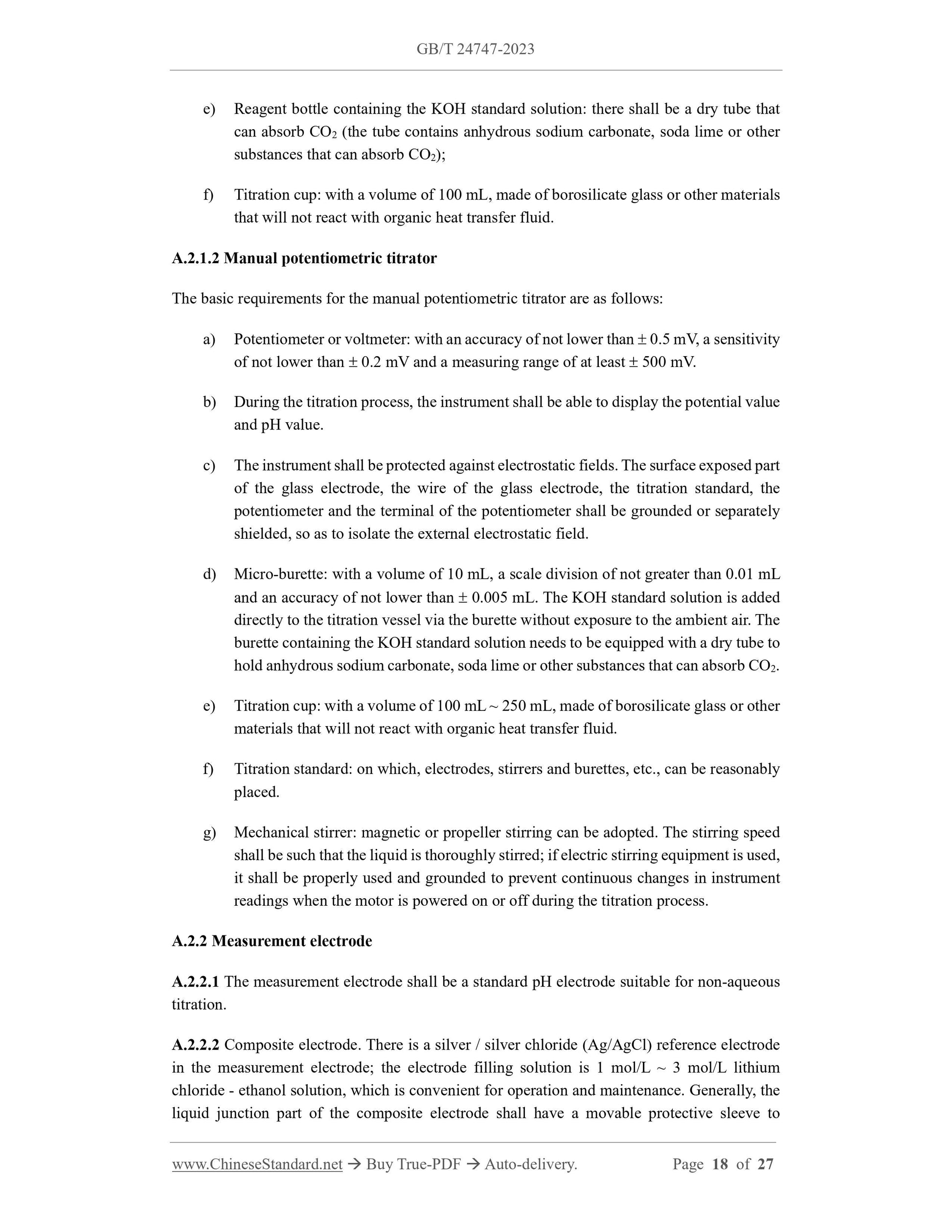1
/
of
12
www.ChineseStandard.us -- Field Test Asia Pte. Ltd.
GB/T 24747-2023 English PDF (GB/T24747-2023)
GB/T 24747-2023 English PDF (GB/T24747-2023)
Regular price
$260.00
Regular price
Sale price
$260.00
Unit price
/
per
Shipping calculated at checkout.
Couldn't load pickup availability
GB/T 24747-2023: Safety technology conditions for organic heat transfer fluid
Delivery: 9 seconds. Download (& Email) true-PDF + Invoice.
Get Quotation: Click GB/T 24747-2023 (Self-service in 1-minute)
Historical versions (Master-website): GB/T 24747-2023
Preview True-PDF (Reload/Scroll-down if blank)
GB/T 24747-2023
GB
NATIONAL STANDARD OF THE
PEOPLE’S REPUBLIC OF CHINA
ICS 27.060.30
CCS J 98
Replacing GB/T 24747-2009
Safety Technology Conditions for Organic Heat Transfer
Fluid
ISSUED ON: MAY 23, 2023
IMPLEMENTED ON: MAY 23, 2023
Issued by: State Administration for Market Regulation;
Standardization Administration of the People’s Republic of China.
Table of Contents
Foreword ... 3
1 Scope ... 6
2 Normative References ... 6
3 Terms and Definitions ... 7
4 General Requirements ... 8
5 Requirements and Test Methods for Quality Indexes ... 9
6 Determination and Disposal ... 11
7 Inspection Cycle and Sampling ... 13
8 Mixed Use ... 14
9 Separation and Disposal of Deteriorated Material ... 15
10 Cleaning of Heat Transfer System ... 15
11 Replacement and Abandonment ... 15
Appendix A (normative) Determination of Acid Value of Organic Heat Transfer Fluid
(by potentiometric titration method) ... 17
Safety Technology Conditions for Organic Heat Transfer
Fluid
1 Scope
This document specifies the safety technology conditions for organic heat transfer fluids used
by various types of boilers and heat transfer systems with organic heat transfer fluids.
This document is applicable to organic heat transfer fluids that use various organic heat transfer
fluid boilers, photothermal energy storage or other heating equipment as heating sources and
for the purpose of indirect heating. It is inapplicable to organic heat transfer fluids that are only
used for freezing and cryogenic cooling, nor is it applicable to organic silicone heat transfer
fluid.
2 Normative References
The contents of the following documents constitute indispensable clauses of this document
through the normative references in the text. In terms of references with a specified date, only
versions with a specified date are applicable to this document. In terms of references without a
specified date, the latest version (including all the modifications) is applicable to this document.
GB/T 261 Determination of Flash Point - Pensky-Martens Closed Cup Method
GB/T 265 Petroleum Products - Determination of Kinematic Viscosity and Calculation of
Dynamic Viscosity
GB/T 4756 Method for Manual Sampling of Petroleum Liquids
GB/T 6536 Standard Test Method for Distillation of Petroleum Products at Atmospheric
Pressure
GB/T 6682 Water for Analytical Laboratory Use - Specification and Test Methods
GB/T 11133 Standard Test Method for Determination of Water in Petroleum Products,
Lubricating Oils, and Additives - Coulometric Karl Fischer Titration Method
GB/T 11137 Black Petroleum Products - Determination of Kinematic Viscosity (reverse-flow
method) and Calculation of Dynamic Viscosity
GB/T 16483 Safety Data Sheet for Chemical Products - Content and Order of Sections
GB/T 23800 Heat Transfer Fluids - Determination of Thermal Stability
3.5 liquid phase organic heat transfer fluid
Liquid phase organic heat transfer fluid is a synthetic organic heat transfer fluid and mineral oil
organic heat transfer fluid with a certain distillation range, which can only be used under liquid
phase conditions.
[source: GB 23971-2009, 3.6, modified]
3.6 maximum working temperature
Maximum working temperature is the maximum temperature of the main fluid of the organic
heat transfer fluid allowed at the boiler outlet under the actual operating conditions of the heat
transfer system.
NOTE: the average main fluid temperature of the organic heat transfer fluid measured at the boiler
outlet is the working temperature.
[source: GB 23971-2009, 3.9, modified]
3.7 initial boiling point; IBP
Initial boiling point is the temperature point, at which, the cumulative area is equal to 0.5% of
the total area of the obtained chromatogram when the petroleum fractions boiling range step-
by-step method is used for determination.
NOTE: the determination of boiling range distribution of petroleum fractions adopts NB/SH/T
0558.
3.8 low-boiling component
Low-boiling component is the substance whose distillation temperature in the organic heat
transfer fluid in use is lower than its initial boiling point when it is unused.
3.9 deteriorated material
Deteriorated material is a general term for substances different from the original properties of
the organic heat transfer fluid and generated under the influence of factors, such as: oxidation,
overheating and mixture of foreign matters, on the organic heat transfer fluid in use.
4 General Requirements
4.1 The organic heat transfer fluid products shall comply with the requirements of GB 23971.
The following documents, for example, product quality certificate, shall be provided at the same
time when the organic heat transfer fluid products are sold.
a) Product type test report that complies with GB 23971 and issued by the organic heat
transfer type test institution.
b) Exit-factory quality inspection report of the batch of products issued by the
manufacturer; if the supplier provides a copy of the report, the authenticity of the
report shall be confirmed by the supplier.
c) Safety data sheet for chemical products that complies with the requirements of GB/T
16483.
4.2 The self-ignition point of the organic heat transfer fluid shall not be lower than the maximum
permitted bulk temperature.
4.3 The maximum permitted bulk temperature of the organic heat transfer fluid shall be at least
10 C higher than the maximum working temperature of the organic heat transfer fluid boiler.
For electric heating boilers, coal-fired boilers or boilers with an average heat flux density
greater than 0.05 MW/m2 on the radiant heating surface of the furnace, the maximum permitted
bulk temperature of the selected organic heat transfer fluid shall be at least 20 C higher than
the maximum working temperature of the organic heat transfer fluid boiler.
4.4 The organic heat transfer fluid at any point in the heat transfer system shall not exceed the
maximum permitted film temperature of the organic heat transfer fluid; the calculated
maximum film temperature of the organic heat transfer fluid boiler shall not be higher than the
maximum permitted film temperature of the organic heat transfer fluid.
4.5 L-QC and L-QD organic heat transfer fluids shall be used in closed circulation systems; L-
QB organic heat transfer fluid can be used in closed or open circulation systems, but the thermal
oxidation stability index of the organic heat transfer fluid used in the open circulation system
shall be qualified, and the temperature of the organic heat transfer fluid in the expansion tank
of the open circulation system shall be lower than 70 C during normal operation. See GB
23971 for the classification of L-QB, L-QC and L-QD.
4.6 The organic heat transfer fluids shall not be directly used to heat or cool oxidizing chemicals.
The organic heat transfer fluids used for indirect heating in the production of food or medicine
shall not only comply with the stipulations of GB 23971, but also satisfy the requirements of
relevant national safety standards on food and medicine.
5 Requirements and Test Methods for Quality Indexes
5.1 Verification Indexes and Test Methods for Unused Organic Heat Transfer
Fluid
Before the unused organic heat transfer fluid is injected into the system (including the unused
organic heat transfer fluid initially injected into the system and the unused organic heat transfer
fluid replaced or supplemented after operation), a quality verification inspection shall be carried
out in accordance with the product type test report. See Table 1 for the inspection items and test
methods.
continuing the use;
d) Within 3 months after replacing or adding different organic heat transfer fluid
products in the system.
7.2 Sampling
7.2.1 The sampling of the unused organic heat transfer fluid shall comply with the requirements
of GB/T 4756; the sampling volume shall be able to satisfy the requirements of verification
inspection and subsequent re-inspection of reserved sample, and the volume of reserved sample
shall not be less than 1 L.
7.2.2 The sampling of the organic heat transfer fluid in use shall be carried out through a non-
water-cooled sampler in the system circulation loop, and the sampling temperature shall not be
higher than 50 C. The obtained sample be a uniform sample representing the quality of the
organic heat transfer fluid currently in use in the system. The sampling volume shall be able to
satisfy the requirements of inspection and re-inspection of reserved sample. The retention time
of the reserved sample for re-inspection shall not be less than 40 d.
8 Mixed Use
8.1 The vapor phase organic heat transfer fluids with different chemical compositions shall not
be mixed, and vapor phase organic heat transfer fluid and liquid phase organic heat transfer
fluid shall not be mixed.
8.2 Generally, organic heat transfer fluids with different chemical and physical properties shall
not be mixed in the same system.
8.3 If it is necessary to mix synthetic liquid phase organic heat transfer fluid with mineral oil
organic heat transfer fluid, or to mix synthetic liquid phase organic heat transfer fluids with
different chemical compositions, and to mix mineral oil organic heat transfer fluids produced
by different manufacturers, the following requirements shall be satisfied:
a) Pass the thermal stability inspection of GB/T 23800, and have a thermal stability
higher than or equivalent to the original organic heat transfer fluid in use;
b) Comply with the requirements of Chapter 4;
c) Before adding, pass the verification inspection specified in Table 1;
d) The manufacturer or supplier provides relevant test or inspection certificates that the
mixed organic heat transfer fluids will not undergo chemical reaction or generate
stratification which may affect safe use.
8.4 The quantity and mixing ratio of mixed organic heat transfer fluids added to the heat transfer
system shall be accurately recorded, and meanwhile, a sampling inspection shall be carried out
on the organic heat transfer fluid after mixing and 1 L of sample shall be reserved for re-
inspection.
8.5 The organic heat transfer fluid after mixing shall be used in accordance with the properties
and performance conditions of the original organic heat transfer fluid in use, and the quality
index shall comply with the requirements of Table 2.
8.6 Various types of additives shall not be added to the organic heat transfer fluid in use, which
may change its physical and chemical properties.
9 Separation and Disposal of Deteriorated Material
9.1 For synthetic organic heat transfer fluid in use that still has disposal value, appropriate
separation and refining methods can be adopted to separate and dispose the deteriorated
material, remove the pollutants and part of the degenerated substances, so as to improve the
quality to a certain extent. After reaching the quality index of normal use in Table 2, it can
continue to be used in the original system.
9.2 The disposal process shall ensure standardization and safety and comply with the
requirements of environmental protection. After the separation and disposal of the deteriorated
material is completed, the organic heat transfer fluid in the system shall be sampled and tested.
After reaching the quality index of normal use, it can continue to be used.
10 Cleaning of Heat Transfer System
10.1 When the organic heat transfer fluid in the system is seriously polluted, the carbon residue
or kinematic viscosity reaches the quality index of discontinued use, or after the boiler tube
undergoes an overheating and overtemperature accident, and before an organic heat transfer
fluid is replaced in the system, the boiler and the system shall be inspected. If there are
remaining pollutants, or coking is generated and residual oil adhesion become serious, which
reaches the cleaning conditions of GB/T 34352, then, an appropriate cleaning mode shall be
adopted to remove the pollutants in the system and the coking in the boiler tube, so as to keep
the system clean and prevent the newly replaced organic heat transfer fluid from being polluted.
10.2 The cleaning and quality of boiler and heat transfer system with organic heat transfer fluids
shall comply with the stipulations of GB/T 34352.
10.3 After the organic heat transfer fluid is injected into a cleaned system and the degassing
operation is completed, a sampling inspection shall be carried out, and its quality shall comply
with the quality index of normal use in Table 2.
11 Replacement and Abandonment
11.1 When the kinematic viscosity, acid value, carbon residue or pollution level of the organic
heat transfer fluid in use are within the range of “quality index of discontinued use” in Table 2,
Appendix A
(normative)
Determination of Acid Value of Organic Heat Transfer Fluid (by potentiometric
titration method)
A.1 Overview
A.1.1 The measurement range of this method (by KOH): 0.01 mg/g ~ 30 mg/g.
A.1.2 In this method, potassium hydroxide - isopropanol standard solution (hereinafter referred
to as KOH standard solution) is taken as the titrant, and a mixed solvent of toluene, isopropanol
and a small amount of water is used to dissolve the sample; through a combination electrode or
a pair of glass indicator electrodes - silver / silver chloride (Ag/AgCl) reference electrodes,
potentiometric titration is performed. In accordance with the volume of the KOH standard
solution consumed and the potential value, draw a titration curve, and judge the endpoint and
stoichiometric point by the jump point on the curve. When there are many kinds of weak acids
in the organic heat transfer fluid, resulting in multiple jump points in the titration process, take
the KOH standard solution consumed at the jump point corresponding to the potential value
closest to the pH 11 0.02 standard buffer solution to calculate the acid value for the endpoint
judgment; if no jump point can be found during the titration process, then, use the volume of
the KOH standard solution consumed when titrated to the p...
Delivery: 9 seconds. Download (& Email) true-PDF + Invoice.
Get Quotation: Click GB/T 24747-2023 (Self-service in 1-minute)
Historical versions (Master-website): GB/T 24747-2023
Preview True-PDF (Reload/Scroll-down if blank)
GB/T 24747-2023
GB
NATIONAL STANDARD OF THE
PEOPLE’S REPUBLIC OF CHINA
ICS 27.060.30
CCS J 98
Replacing GB/T 24747-2009
Safety Technology Conditions for Organic Heat Transfer
Fluid
ISSUED ON: MAY 23, 2023
IMPLEMENTED ON: MAY 23, 2023
Issued by: State Administration for Market Regulation;
Standardization Administration of the People’s Republic of China.
Table of Contents
Foreword ... 3
1 Scope ... 6
2 Normative References ... 6
3 Terms and Definitions ... 7
4 General Requirements ... 8
5 Requirements and Test Methods for Quality Indexes ... 9
6 Determination and Disposal ... 11
7 Inspection Cycle and Sampling ... 13
8 Mixed Use ... 14
9 Separation and Disposal of Deteriorated Material ... 15
10 Cleaning of Heat Transfer System ... 15
11 Replacement and Abandonment ... 15
Appendix A (normative) Determination of Acid Value of Organic Heat Transfer Fluid
(by potentiometric titration method) ... 17
Safety Technology Conditions for Organic Heat Transfer
Fluid
1 Scope
This document specifies the safety technology conditions for organic heat transfer fluids used
by various types of boilers and heat transfer systems with organic heat transfer fluids.
This document is applicable to organic heat transfer fluids that use various organic heat transfer
fluid boilers, photothermal energy storage or other heating equipment as heating sources and
for the purpose of indirect heating. It is inapplicable to organic heat transfer fluids that are only
used for freezing and cryogenic cooling, nor is it applicable to organic silicone heat transfer
fluid.
2 Normative References
The contents of the following documents constitute indispensable clauses of this document
through the normative references in the text. In terms of references with a specified date, only
versions with a specified date are applicable to this document. In terms of references without a
specified date, the latest version (including all the modifications) is applicable to this document.
GB/T 261 Determination of Flash Point - Pensky-Martens Closed Cup Method
GB/T 265 Petroleum Products - Determination of Kinematic Viscosity and Calculation of
Dynamic Viscosity
GB/T 4756 Method for Manual Sampling of Petroleum Liquids
GB/T 6536 Standard Test Method for Distillation of Petroleum Products at Atmospheric
Pressure
GB/T 6682 Water for Analytical Laboratory Use - Specification and Test Methods
GB/T 11133 Standard Test Method for Determination of Water in Petroleum Products,
Lubricating Oils, and Additives - Coulometric Karl Fischer Titration Method
GB/T 11137 Black Petroleum Products - Determination of Kinematic Viscosity (reverse-flow
method) and Calculation of Dynamic Viscosity
GB/T 16483 Safety Data Sheet for Chemical Products - Content and Order of Sections
GB/T 23800 Heat Transfer Fluids - Determination of Thermal Stability
3.5 liquid phase organic heat transfer fluid
Liquid phase organic heat transfer fluid is a synthetic organic heat transfer fluid and mineral oil
organic heat transfer fluid with a certain distillation range, which can only be used under liquid
phase conditions.
[source: GB 23971-2009, 3.6, modified]
3.6 maximum working temperature
Maximum working temperature is the maximum temperature of the main fluid of the organic
heat transfer fluid allowed at the boiler outlet under the actual operating conditions of the heat
transfer system.
NOTE: the average main fluid temperature of the organic heat transfer fluid measured at the boiler
outlet is the working temperature.
[source: GB 23971-2009, 3.9, modified]
3.7 initial boiling point; IBP
Initial boiling point is the temperature point, at which, the cumulative area is equal to 0.5% of
the total area of the obtained chromatogram when the petroleum fractions boiling range step-
by-step method is used for determination.
NOTE: the determination of boiling range distribution of petroleum fractions adopts NB/SH/T
0558.
3.8 low-boiling component
Low-boiling component is the substance whose distillation temperature in the organic heat
transfer fluid in use is lower than its initial boiling point when it is unused.
3.9 deteriorated material
Deteriorated material is a general term for substances different from the original properties of
the organic heat transfer fluid and generated under the influence of factors, such as: oxidation,
overheating and mixture of foreign matters, on the organic heat transfer fluid in use.
4 General Requirements
4.1 The organic heat transfer fluid products shall comply with the requirements of GB 23971.
The following documents, for example, product quality certificate, shall be provided at the same
time when the organic heat transfer fluid products are sold.
a) Product type test report that complies with GB 23971 and issued by the organic heat
transfer type test institution.
b) Exit-factory quality inspection report of the batch of products issued by the
manufacturer; if the supplier provides a copy of the report, the authenticity of the
report shall be confirmed by the supplier.
c) Safety data sheet for chemical products that complies with the requirements of GB/T
16483.
4.2 The self-ignition point of the organic heat transfer fluid shall not be lower than the maximum
permitted bulk temperature.
4.3 The maximum permitted bulk temperature of the organic heat transfer fluid shall be at least
10 C higher than the maximum working temperature of the organic heat transfer fluid boiler.
For electric heating boilers, coal-fired boilers or boilers with an average heat flux density
greater than 0.05 MW/m2 on the radiant heating surface of the furnace, the maximum permitted
bulk temperature of the selected organic heat transfer fluid shall be at least 20 C higher than
the maximum working temperature of the organic heat transfer fluid boiler.
4.4 The organic heat transfer fluid at any point in the heat transfer system shall not exceed the
maximum permitted film temperature of the organic heat transfer fluid; the calculated
maximum film temperature of the organic heat transfer fluid boiler shall not be higher than the
maximum permitted film temperature of the organic heat transfer fluid.
4.5 L-QC and L-QD organic heat transfer fluids shall be used in closed circulation systems; L-
QB organic heat transfer fluid can be used in closed or open circulation systems, but the thermal
oxidation stability index of the organic heat transfer fluid used in the open circulation system
shall be qualified, and the temperature of the organic heat transfer fluid in the expansion tank
of the open circulation system shall be lower than 70 C during normal operation. See GB
23971 for the classification of L-QB, L-QC and L-QD.
4.6 The organic heat transfer fluids shall not be directly used to heat or cool oxidizing chemicals.
The organic heat transfer fluids used for indirect heating in the production of food or medicine
shall not only comply with the stipulations of GB 23971, but also satisfy the requirements of
relevant national safety standards on food and medicine.
5 Requirements and Test Methods for Quality Indexes
5.1 Verification Indexes and Test Methods for Unused Organic Heat Transfer
Fluid
Before the unused organic heat transfer fluid is injected into the system (including the unused
organic heat transfer fluid initially injected into the system and the unused organic heat transfer
fluid replaced or supplemented after operation), a quality verification inspection shall be carried
out in accordance with the product type test report. See Table 1 for the inspection items and test
methods.
continuing the use;
d) Within 3 months after replacing or adding different organic heat transfer fluid
products in the system.
7.2 Sampling
7.2.1 The sampling of the unused organic heat transfer fluid shall comply with the requirements
of GB/T 4756; the sampling volume shall be able to satisfy the requirements of verification
inspection and subsequent re-inspection of reserved sample, and the volume of reserved sample
shall not be less than 1 L.
7.2.2 The sampling of the organic heat transfer fluid in use shall be carried out through a non-
water-cooled sampler in the system circulation loop, and the sampling temperature shall not be
higher than 50 C. The obtained sample be a uniform sample representing the quality of the
organic heat transfer fluid currently in use in the system. The sampling volume shall be able to
satisfy the requirements of inspection and re-inspection of reserved sample. The retention time
of the reserved sample for re-inspection shall not be less than 40 d.
8 Mixed Use
8.1 The vapor phase organic heat transfer fluids with different chemical compositions shall not
be mixed, and vapor phase organic heat transfer fluid and liquid phase organic heat transfer
fluid shall not be mixed.
8.2 Generally, organic heat transfer fluids with different chemical and physical properties shall
not be mixed in the same system.
8.3 If it is necessary to mix synthetic liquid phase organic heat transfer fluid with mineral oil
organic heat transfer fluid, or to mix synthetic liquid phase organic heat transfer fluids with
different chemical compositions, and to mix mineral oil organic heat transfer fluids produced
by different manufacturers, the following requirements shall be satisfied:
a) Pass the thermal stability inspection of GB/T 23800, and have a thermal stability
higher than or equivalent to the original organic heat transfer fluid in use;
b) Comply with the requirements of Chapter 4;
c) Before adding, pass the verification inspection specified in Table 1;
d) The manufacturer or supplier provides relevant test or inspection certificates that the
mixed organic heat transfer fluids will not undergo chemical reaction or generate
stratification which may affect safe use.
8.4 The quantity and mixing ratio of mixed organic heat transfer fluids added to the heat transfer
system shall be accurately recorded, and meanwhile, a sampling inspection shall be carried out
on the organic heat transfer fluid after mixing and 1 L of sample shall be reserved for re-
inspection.
8.5 The organic heat transfer fluid after mixing shall be used in accordance with the properties
and performance conditions of the original organic heat transfer fluid in use, and the quality
index shall comply with the requirements of Table 2.
8.6 Various types of additives shall not be added to the organic heat transfer fluid in use, which
may change its physical and chemical properties.
9 Separation and Disposal of Deteriorated Material
9.1 For synthetic organic heat transfer fluid in use that still has disposal value, appropriate
separation and refining methods can be adopted to separate and dispose the deteriorated
material, remove the pollutants and part of the degenerated substances, so as to improve the
quality to a certain extent. After reaching the quality index of normal use in Table 2, it can
continue to be used in the original system.
9.2 The disposal process shall ensure standardization and safety and comply with the
requirements of environmental protection. After the separation and disposal of the deteriorated
material is completed, the organic heat transfer fluid in the system shall be sampled and tested.
After reaching the quality index of normal use, it can continue to be used.
10 Cleaning of Heat Transfer System
10.1 When the organic heat transfer fluid in the system is seriously polluted, the carbon residue
or kinematic viscosity reaches the quality index of discontinued use, or after the boiler tube
undergoes an overheating and overtemperature accident, and before an organic heat transfer
fluid is replaced in the system, the boiler and the system shall be inspected. If there are
remaining pollutants, or coking is generated and residual oil adhesion become serious, which
reaches the cleaning conditions of GB/T 34352, then, an appropriate cleaning mode shall be
adopted to remove the pollutants in the system and the coking in the boiler tube, so as to keep
the system clean and prevent the newly replaced organic heat transfer fluid from being polluted.
10.2 The cleaning and quality of boiler and heat transfer system with organic heat transfer fluids
shall comply with the stipulations of GB/T 34352.
10.3 After the organic heat transfer fluid is injected into a cleaned system and the degassing
operation is completed, a sampling inspection shall be carried out, and its quality shall comply
with the quality index of normal use in Table 2.
11 Replacement and Abandonment
11.1 When the kinematic viscosity, acid value, carbon residue or pollution level of the organic
heat transfer fluid in use are within the range of “quality index of discontinued use” in Table 2,
Appendix A
(normative)
Determination of Acid Value of Organic Heat Transfer Fluid (by potentiometric
titration method)
A.1 Overview
A.1.1 The measurement range of this method (by KOH): 0.01 mg/g ~ 30 mg/g.
A.1.2 In this method, potassium hydroxide - isopropanol standard solution (hereinafter referred
to as KOH standard solution) is taken as the titrant, and a mixed solvent of toluene, isopropanol
and a small amount of water is used to dissolve the sample; through a combination electrode or
a pair of glass indicator electrodes - silver / silver chloride (Ag/AgCl) reference electrodes,
potentiometric titration is performed. In accordance with the volume of the KOH standard
solution consumed and the potential value, draw a titration curve, and judge the endpoint and
stoichiometric point by the jump point on the curve. When there are many kinds of weak acids
in the organic heat transfer fluid, resulting in multiple jump points in the titration process, take
the KOH standard solution consumed at the jump point corresponding to the potential value
closest to the pH 11 0.02 standard buffer solution to calculate the acid value for the endpoint
judgment; if no jump point can be found during the titration process, then, use the volume of
the KOH standard solution consumed when titrated to the p...
Share
